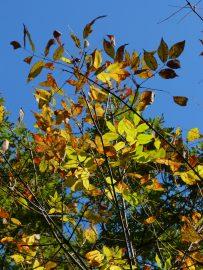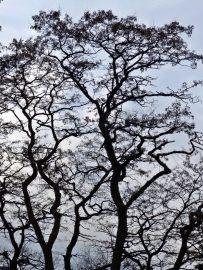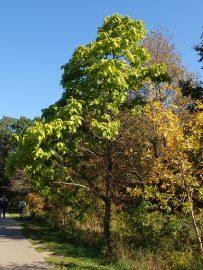Based on an article compiled by Devon Turcotte et al. for High Park News, Winter/Spring 2007
Many species of deciduous and coniferous trees grow in High Park's diverse habitats.
Black Oak (Quercus velutina)
In the savannah areas of High Park the predominant tree is the Black Oak.
Eastern White Pine (Pinus strobus)
This tree has a very wide range in Canada, including High Park. White pines are found anywhere from southeast Manitoba to Newfoundland. Eastern white pines can grow to a height of 33 m (100 ft.) with a diameter of 0.9-1.2 m (3-4 ft.) and thrive best in sandy, well-drained soils. Needles grow in slender, blue-green bundles, 6-13 cm (2.5-5 in) long. Cones are a yellow-brown colour, narrow and cylindrical in shape. The cone scales are thin, rounded and flat. Bark is typically grey and becomes rough and thick over many years of growth. At one time, Eastern white pines were the most valuable tree in the northeast, commonly used in construction. The tall, straight trunks made perfect masts for ships during the colonial period.
Black Ash (Fraxinus nigra)
Also known as the “basket ash” or the “hoop ash,” this tree also grows in many places across Canada in a range very similar to the Eastern white pine – southeast Manitoba to Newfoundland. The Black ash grows to a height of 9-15 m (30-50 ft.) and has a diameter of approximately 0.3 m (1 ft.).
Black ashes grow best in wet soils, and particularly prefer cold, poorly drained swamps. They also grow in conifer or hardwood forests. The leaves are broadly lance-shaped, have a fine, saw-tooth edge and no stalk. They are dark green on top and have rust-coloured hairs along the mid-vein on the bottom. They turn brown in autumn. This tree produces both flowers and fruit. The flowers are long and purplish in colour, growing in small clusters. The fruit is a 2.5-4 cm (1-1.5 in.) key which matures late in summer. The Black ash derives its nicknames from traditional uses of its wood to make baskets, barrel hoops and woven chair bottoms.
Honeylocust (Gleditsia triancanthos)
In Canada, the Honeylocust is found only in the southernmost parts of Ontario. It stretches up to a height of approximately 24 m (80 ft.) and reaches a diameter of 0.8 m (2.5 ft.).
Honeylocusts grow well in mixed forests, preferring the moist soils found in river floodplains. The leaves of the Honeylocust are a shiny green colour on top with fine wavy edges, paired with no stalk. The underside is a dull yellow-green colour and the leaves turn yellow in autumn. The flowers are a greenish-yellow colour and covered in fine hairs. They are bell-shaped with five petals each. The fruit of the Honeylocust is a 15-41 cm (6-16 in.) wide, flat pod. These pods shed unopened late in the fall and inside is many dark brown seeds in an edible pulp.
Black locust Robinia pseudoacacia, which is native to the southern Appalachians and the Ozarks, also occurs in High Park.
Catalpa (Catalpa speciosa)
The catalpa is a tree with a rounded crown of spreading branches. The leaves are broad and heart-shaped, dull green in colour which darkens to a blackish colour in the fall. The tree bears long, cylindrical brown fruit that resembles a cigar or a bean. The fruit matures in autumn, but remains attached in winter. The purple-spotted, orange-striped white flowers of the tree stand in branched, upright clusters. They are approximately 5-6 cm (2-2 ¼ in.) long and appear in late spring. Catalpas grow to a height of 15-24 m (50-80 ft) and can be found in naturalized open areas such as roadsides and clearings, as well as in moist valley soils by streams. This tree is native to Ontario but not indigenous to High Park. It has been found in the northeast corner of the park near the Forest School.
Sassafras (Sassafras albidum)
Sassafras is an unusual tree of the Carolinian forest in Ontario. It has three different leaf shapes – one looks like a normal leaf, the next looks like a mitten, and the third has three lobes – all on the same tree!
Sassafras has a spicy sweet scent and has been around since the dinosaurs. It has a wonderful history, both botanically and in its relationship with humans. The use of its roots to make root beer is now prohibited. In the 1600s, it was one of the top exports to Europe as it was believed to be a cure for the new disease, syphilis.
Sources
See also
-
- The Oaks of High Park
- Acorns in High Park
- Tree list from High Park Woodland & Savannah Management Plan, 2002
- High Park Tree Tour Map on Canadian Tree Tours website
- TD TreeBee, Tree ID - Excellent resource for tree identification with photos of all parts of the tree.
- Trees, Shrubs & Vines of Toronto, Toronto Biodiversity Booklet Series






























